Italy: Lucca
Dec 27, 2023 14:09:29 #
We arrived in Lucca in late morning and were given the option of either a bike ride around the city walls or a walking tour with a local guide. Since I haven't perfected my photography technique from a moving bicycle, we opted for the latter. I hope you enjoy these next few sets from beautiful Lucca!
Lucca (/ˈluːkə/ LOO-kə, Italian: [ˈlukka] ⓘ) is a city and comune in Tuscany, Central Italy, on the Serchio River, in a fertile plain near the Ligurian Sea. The city has a population of about 89,000, while its province has a population of 383,957.
Lucca is known as an Italian "Città d'arte" (City of Art) from its intact Renaissance-era city walls and its very well preserved historic center, where, among other buildings and monuments, are located the Piazza dell'Anfiteatro, which has its origins in the second half of the 1st century A.D. and the Guinigi Tower, a 45-metre-tall (150 ft) tower that dates from the 1300s.
The city is also the birthplace of numerous world-class composers, including Giacomo Puccini, Alfredo Catalani, and Luigi Boccherini.
Toponymy
By the Romans, Lucca was known as Luca. From more recent and concrete toponymic studies, the name Lucca has references that lead to "sacred grove" (Latin: lucus), "to cut" (Latin: lucare) and "luminous space" (leuk, a term used by the first European populations). The origin apparently refers to a wooded area deforested to make room for light or to a clearing located on a river island of Serchio debris, in the middle of wooded areas.
History
Antiquity
The territory of present-day Lucca was certainly settled by the Etruscans, having also traces of a probable earlier Ligurian presence (called Luk meaning "marsh", which has already been speculated as a possible origin for the city's name), dating from 3rd century BC. However, it was only with the arrival of the Romans, that the area took on the appearance of a real town, obtaining the status of a Roman colony in 180 BC, and transformed into a town hall in 89 BC.
The rectangular grid of its historical centre preserves the Roman street plan, and the Piazza San Michele occupies the site of the ancient forum. The outline of the Roman amphitheatre is still seen in the Piazza dell'Anfiteatro, and the outline of a Roman theater is visible in Piazza Sant'Augostino. Fragments of the Roman-era walls are incorporated into the church of Santa Maria della Rosa.
At the Lucca Conference, in 56 BC, Julius Caesar, Pompey, and Crassus reaffirmed their political alliance known as the First Triumvirate.
Middle Ages
Frediano, an Irish monk, was bishop of Lucca in the early sixth century. At one point, Lucca was plundered by Odoacer, the first Germanic King of Italy. Lucca was an important city and fortress even in the sixth century, when Narses besieged it for several months in 553. From 576 to 797, under the Lombards, it was the capital of a duchy, known as Duchy of Tuscia, which included a large part of today's Tuscany and the province of Viterbo, during this time the city also minted its own coins. The Holy Face of Lucca (or Volto Santo), a major relic supposedly carved by Nicodemus, arrived in 742.
Among the population that inhabited Lucca in the medieval era, there was also a significant presence of Jews. The first mention of their presence in the city is from a document from the year 859. The jewish community was led by the Kalonymos family (which later became a major component of proto-Ashkenazic Jewry).
Thanks above all to the Holy Face and to the relics of important saints, such as San Regolo and Saint Fridianus, the city was one of the main destinations of the Via Francigena, the major pilgrimage route to Rome from the north.
The Lucca cloth was a silk fabric that was woven with gold or silver threads. It was a popular type of textile in Lucca throughout the mediaeval period.
Lucca became prosperous through the silk trade that began in the eleventh century, and came to rival the silks of Byzantium. During the tenth–eleventh centuries Lucca was the capital of the feudal margraviate of Tuscany, more or less independent but owing nominal allegiance to the Holy Roman Emperor.
In 1057, Anselm of Baggio (later Pope Alexander II) was appointed bishop of Lucca, a position he held also during the papacy. As bishop of Lucca he managed to rebuild the patrimony of the Church of Lucca, recovering alienated assets, obtaining numerous donations thanks to his prestige, and had the Cathedral of the city rebuilt. From 1073 to 1086, the bishop of Lucca was his nephew Anselm II, a prominent figure in the Investiture Controversy.
During the High Middle Ages, one of the most illustrious dynasties of Lucca was the noble Allucingoli family, who managed to forge strong ties with the Church. Among the family members were Ubaldo Allucingoli, who was elected to the Papacy as Pope Lucius III in 1181, and the Cardinals Gerardo Allucingoli and Uberto Allucingoli.
Republican period (12th to 19th century)
After the death of Matilda of Tuscany, the city began to constitute itself an independent commune with a charter in 1160. For almost 500 years, Lucca remained an independent republic. There were many minor provinces in the region between southern Liguria and northern Tuscany dominated by the Malaspina; Tuscany in this time was a part of feudal Europe. Dante's Divine Comedy includes many references to the great feudal families who had huge jurisdictions with administrative and judicial rights. Dante spent some of his exile in Lucca.
In 1273 and again in 1277, Lucca was ruled by a Guelph capitano del popolo (captain of the people) named Luchetto Gattilusio. In 1314, internal discord allowed Uguccione della Faggiuola of Pisa to make himself lord of Lucca. The Lucchesi expelled him two years later, and handed over the city to another condottiero, Castruccio Castracani, under whose rule it became a leading state in central Italy. Lucca rivalled Florence until Castracani's death in 1328. On 22 and 23 September 1325, in the battle of Altopascio, Castracani defeated Florence's Guelphs. For this he was nominated by Louis IV the Bavarian to become duke of Lucca. Castracani's tomb is in the church of San Francesco. His biography is Machiavelli's third famous book on political rule.
Occupied by the troops of Louis of Bavaria, the city was sold to a rich Genoese, Gherardino Spinola, then seized by John, king of Bohemia. Pawned to the Rossi of Parma, by them it was ceded to Mastino II della Scala of Verona, sold to the Florentines, surrendered to the Pisans, and then nominally liberated by the emperor Charles IV and governed by his vicar.
In 1408, Lucca hosted a convocation organized by Pope Gregory XII with his cardinals intended to end the schism in the papacy.
Lucca managed, at first as a democracy, and after 1628 as an oligarchy, to maintain its independence alongside of Venice and Genoa, and painted the word Libertas on its banner until the French Revolution in 1789.
Early modern period
Lucca had been the second largest Italian city state (after Venice) with a republican constitution ("comune") to remain independent over the centuries.
Between 1799 and 1800, it was contested by the French and Austrian armies. Finally the French prevailed and granted a democratic constitution in the 1801. However, already in 1805 the Republic of Lucca was converted into a monarchy by Napoleon, who installed his sister Elisa Bonaparte Baciocchi as "Princess of Lucca".
From 1815 to 1847, it was a Bourbon-Parma duchy. The only reigning dukes of Lucca were Maria Luisa of Spain, who was succeeded by her son Charles II, Duke of Parma in 1824. Meanwhile, the Duchy of Parma had been assigned for life to Marie Louise, Duchess of Parma, the second wife of Napoleon. In accordance with the Treaty of Vienna (1815), upon the death of Marie Louise, Duchess of Parma in 1847, Parma reverted to Charles II, Duke of Parma, while Lucca lost independence and was annexed to the Grand Duchy of Tuscany. As part of Tuscany, it became part of the Kingdom of Sardinia in 1860 and finally part of the Italian State in 1861.
World War II internment camp
In 1942, during World War II, a prisoner-of-war camp was established at the village of Colle di Compito, in the municipality of Capannori, about 11 kilometres (6.8 mi) from Lucca. Its official number was P.G. (prigionieri di guerra) 60, and it was usually referred to as PG 60 Lucca. Although it never had permanent structures and accommodation consisted of tents in an area prone to flooding, it housed more than 3,000 British and Commonwealth prisoners of war during the period of its existence. It was handed over to the Germans on 10 September 1943, not long after the signing of the Italian armistice. During the Italian Social Republic, as a puppet state of the Germans, political prisoners, foreigners, common law prisoners and Jews were interned there, and it functioned as a concentration camp. In June 1944, the prisoners were moved to Bagni di Lucca.
Culture
Lucca is the birthplace of composers Giacomo Puccini (La Bohème and Madama Butterfly), Nicolao Dorati, Francesco Geminiani, Gioseffo Guami, Luigi Boccherini, and Alfredo Catalani. It is also the birthplace of artist Benedetto Brandimarte. Since 2004, Lucca is home to IMT Lucca, a public research institution and a selective graduate school and part of the Superior Graduate Schools in Italy (Grandes écoles).
Architecture
Lucca is also known for its marble deposits. After a fire in the early 1900s, the West Wing of the Legislative Assembly of Ontario was rebuilt with marble sourced in Lucca. The floor mosaic in the West Wing was hand-laid and is constructed entirely of Italian, Lucca marble.
Walls, streets, and squares
The walls encircling the old town remain intact, even though the city has expanded and been modernised, which is unusual for cities in this region. These walls were built initially as a defensive rampart which, after losing their military importance, became a pedestrian promenade (the Passeggiata delle Mure Urbane) atop the walls which not only links the Bastions of Santa Croce, San Frediano, San Martino, San Pietro/Battisti, San Salvatore, La Libertà/Cairoli, San Regolo, San Colombano, Santa Maria, San Paolino/Catalani and San Donato but also passes over the gates (Porte) of San Donato, Santa Maria, San Jacopo, Elisa, San Pietro, and Sant'Anna. Each of the four principal sides of the structure is lined with a tree species different from the others.
The walled city is encircled by Piazzale Boccherini, Viale Lazzaro Papi, Viale Carlo Del Prete, Piazzale Martiri della Libertà, Via Batoni, Viale Agostino Marti, Viale G. Marconi (vide Guglielmo Marconi), Piazza Don A. Mei, Viale Pacini, Viale Giusti, Piazza Curtatone, Piazzale Ricasoli, Viale Ricasoli, Piazza Risorgimento (vide Risorgimento), and Viale Giosuè Carducci.
The town includes a number of public squares, most notably the Piazza dell'Anfiteatro, (site of the ancient Roman amphitheater), the Piazzale Verdi, the Piazza Napoleone, and the Piazza San Michele.
https://en.wikipedia.org/wiki/Lucca
For images of the drive to Lucca, please see my previous posts:
https://www.uglyhedgehog.com/t-795222-1.html#14351380
https://www.uglyhedgehog.com/t-795492-1.html#14356569
I hope you enjoy these!
Mark
Lucca (/ˈluːkə/ LOO-kə, Italian: [ˈlukka] ⓘ) is a city and comune in Tuscany, Central Italy, on the Serchio River, in a fertile plain near the Ligurian Sea. The city has a population of about 89,000, while its province has a population of 383,957.
Lucca is known as an Italian "Città d'arte" (City of Art) from its intact Renaissance-era city walls and its very well preserved historic center, where, among other buildings and monuments, are located the Piazza dell'Anfiteatro, which has its origins in the second half of the 1st century A.D. and the Guinigi Tower, a 45-metre-tall (150 ft) tower that dates from the 1300s.
The city is also the birthplace of numerous world-class composers, including Giacomo Puccini, Alfredo Catalani, and Luigi Boccherini.
Toponymy
By the Romans, Lucca was known as Luca. From more recent and concrete toponymic studies, the name Lucca has references that lead to "sacred grove" (Latin: lucus), "to cut" (Latin: lucare) and "luminous space" (leuk, a term used by the first European populations). The origin apparently refers to a wooded area deforested to make room for light or to a clearing located on a river island of Serchio debris, in the middle of wooded areas.
History
Antiquity
The territory of present-day Lucca was certainly settled by the Etruscans, having also traces of a probable earlier Ligurian presence (called Luk meaning "marsh", which has already been speculated as a possible origin for the city's name), dating from 3rd century BC. However, it was only with the arrival of the Romans, that the area took on the appearance of a real town, obtaining the status of a Roman colony in 180 BC, and transformed into a town hall in 89 BC.
The rectangular grid of its historical centre preserves the Roman street plan, and the Piazza San Michele occupies the site of the ancient forum. The outline of the Roman amphitheatre is still seen in the Piazza dell'Anfiteatro, and the outline of a Roman theater is visible in Piazza Sant'Augostino. Fragments of the Roman-era walls are incorporated into the church of Santa Maria della Rosa.
At the Lucca Conference, in 56 BC, Julius Caesar, Pompey, and Crassus reaffirmed their political alliance known as the First Triumvirate.
Middle Ages
Frediano, an Irish monk, was bishop of Lucca in the early sixth century. At one point, Lucca was plundered by Odoacer, the first Germanic King of Italy. Lucca was an important city and fortress even in the sixth century, when Narses besieged it for several months in 553. From 576 to 797, under the Lombards, it was the capital of a duchy, known as Duchy of Tuscia, which included a large part of today's Tuscany and the province of Viterbo, during this time the city also minted its own coins. The Holy Face of Lucca (or Volto Santo), a major relic supposedly carved by Nicodemus, arrived in 742.
Among the population that inhabited Lucca in the medieval era, there was also a significant presence of Jews. The first mention of their presence in the city is from a document from the year 859. The jewish community was led by the Kalonymos family (which later became a major component of proto-Ashkenazic Jewry).
Thanks above all to the Holy Face and to the relics of important saints, such as San Regolo and Saint Fridianus, the city was one of the main destinations of the Via Francigena, the major pilgrimage route to Rome from the north.
The Lucca cloth was a silk fabric that was woven with gold or silver threads. It was a popular type of textile in Lucca throughout the mediaeval period.
Lucca became prosperous through the silk trade that began in the eleventh century, and came to rival the silks of Byzantium. During the tenth–eleventh centuries Lucca was the capital of the feudal margraviate of Tuscany, more or less independent but owing nominal allegiance to the Holy Roman Emperor.
In 1057, Anselm of Baggio (later Pope Alexander II) was appointed bishop of Lucca, a position he held also during the papacy. As bishop of Lucca he managed to rebuild the patrimony of the Church of Lucca, recovering alienated assets, obtaining numerous donations thanks to his prestige, and had the Cathedral of the city rebuilt. From 1073 to 1086, the bishop of Lucca was his nephew Anselm II, a prominent figure in the Investiture Controversy.
During the High Middle Ages, one of the most illustrious dynasties of Lucca was the noble Allucingoli family, who managed to forge strong ties with the Church. Among the family members were Ubaldo Allucingoli, who was elected to the Papacy as Pope Lucius III in 1181, and the Cardinals Gerardo Allucingoli and Uberto Allucingoli.
Republican period (12th to 19th century)
After the death of Matilda of Tuscany, the city began to constitute itself an independent commune with a charter in 1160. For almost 500 years, Lucca remained an independent republic. There were many minor provinces in the region between southern Liguria and northern Tuscany dominated by the Malaspina; Tuscany in this time was a part of feudal Europe. Dante's Divine Comedy includes many references to the great feudal families who had huge jurisdictions with administrative and judicial rights. Dante spent some of his exile in Lucca.
In 1273 and again in 1277, Lucca was ruled by a Guelph capitano del popolo (captain of the people) named Luchetto Gattilusio. In 1314, internal discord allowed Uguccione della Faggiuola of Pisa to make himself lord of Lucca. The Lucchesi expelled him two years later, and handed over the city to another condottiero, Castruccio Castracani, under whose rule it became a leading state in central Italy. Lucca rivalled Florence until Castracani's death in 1328. On 22 and 23 September 1325, in the battle of Altopascio, Castracani defeated Florence's Guelphs. For this he was nominated by Louis IV the Bavarian to become duke of Lucca. Castracani's tomb is in the church of San Francesco. His biography is Machiavelli's third famous book on political rule.
Occupied by the troops of Louis of Bavaria, the city was sold to a rich Genoese, Gherardino Spinola, then seized by John, king of Bohemia. Pawned to the Rossi of Parma, by them it was ceded to Mastino II della Scala of Verona, sold to the Florentines, surrendered to the Pisans, and then nominally liberated by the emperor Charles IV and governed by his vicar.
In 1408, Lucca hosted a convocation organized by Pope Gregory XII with his cardinals intended to end the schism in the papacy.
Lucca managed, at first as a democracy, and after 1628 as an oligarchy, to maintain its independence alongside of Venice and Genoa, and painted the word Libertas on its banner until the French Revolution in 1789.
Early modern period
Lucca had been the second largest Italian city state (after Venice) with a republican constitution ("comune") to remain independent over the centuries.
Between 1799 and 1800, it was contested by the French and Austrian armies. Finally the French prevailed and granted a democratic constitution in the 1801. However, already in 1805 the Republic of Lucca was converted into a monarchy by Napoleon, who installed his sister Elisa Bonaparte Baciocchi as "Princess of Lucca".
From 1815 to 1847, it was a Bourbon-Parma duchy. The only reigning dukes of Lucca were Maria Luisa of Spain, who was succeeded by her son Charles II, Duke of Parma in 1824. Meanwhile, the Duchy of Parma had been assigned for life to Marie Louise, Duchess of Parma, the second wife of Napoleon. In accordance with the Treaty of Vienna (1815), upon the death of Marie Louise, Duchess of Parma in 1847, Parma reverted to Charles II, Duke of Parma, while Lucca lost independence and was annexed to the Grand Duchy of Tuscany. As part of Tuscany, it became part of the Kingdom of Sardinia in 1860 and finally part of the Italian State in 1861.
World War II internment camp
In 1942, during World War II, a prisoner-of-war camp was established at the village of Colle di Compito, in the municipality of Capannori, about 11 kilometres (6.8 mi) from Lucca. Its official number was P.G. (prigionieri di guerra) 60, and it was usually referred to as PG 60 Lucca. Although it never had permanent structures and accommodation consisted of tents in an area prone to flooding, it housed more than 3,000 British and Commonwealth prisoners of war during the period of its existence. It was handed over to the Germans on 10 September 1943, not long after the signing of the Italian armistice. During the Italian Social Republic, as a puppet state of the Germans, political prisoners, foreigners, common law prisoners and Jews were interned there, and it functioned as a concentration camp. In June 1944, the prisoners were moved to Bagni di Lucca.
Culture
Lucca is the birthplace of composers Giacomo Puccini (La Bohème and Madama Butterfly), Nicolao Dorati, Francesco Geminiani, Gioseffo Guami, Luigi Boccherini, and Alfredo Catalani. It is also the birthplace of artist Benedetto Brandimarte. Since 2004, Lucca is home to IMT Lucca, a public research institution and a selective graduate school and part of the Superior Graduate Schools in Italy (Grandes écoles).
Architecture
Lucca is also known for its marble deposits. After a fire in the early 1900s, the West Wing of the Legislative Assembly of Ontario was rebuilt with marble sourced in Lucca. The floor mosaic in the West Wing was hand-laid and is constructed entirely of Italian, Lucca marble.
Walls, streets, and squares
The walls encircling the old town remain intact, even though the city has expanded and been modernised, which is unusual for cities in this region. These walls were built initially as a defensive rampart which, after losing their military importance, became a pedestrian promenade (the Passeggiata delle Mure Urbane) atop the walls which not only links the Bastions of Santa Croce, San Frediano, San Martino, San Pietro/Battisti, San Salvatore, La Libertà/Cairoli, San Regolo, San Colombano, Santa Maria, San Paolino/Catalani and San Donato but also passes over the gates (Porte) of San Donato, Santa Maria, San Jacopo, Elisa, San Pietro, and Sant'Anna. Each of the four principal sides of the structure is lined with a tree species different from the others.
The walled city is encircled by Piazzale Boccherini, Viale Lazzaro Papi, Viale Carlo Del Prete, Piazzale Martiri della Libertà, Via Batoni, Viale Agostino Marti, Viale G. Marconi (vide Guglielmo Marconi), Piazza Don A. Mei, Viale Pacini, Viale Giusti, Piazza Curtatone, Piazzale Ricasoli, Viale Ricasoli, Piazza Risorgimento (vide Risorgimento), and Viale Giosuè Carducci.
The town includes a number of public squares, most notably the Piazza dell'Anfiteatro, (site of the ancient Roman amphitheater), the Piazzale Verdi, the Piazza Napoleone, and the Piazza San Michele.
https://en.wikipedia.org/wiki/Lucca
For images of the drive to Lucca, please see my previous posts:
https://www.uglyhedgehog.com/t-795222-1.html#14351380
https://www.uglyhedgehog.com/t-795492-1.html#14356569
I hope you enjoy these!
Mark
Slightly out of sequence, but I love this one of Gail on the wall.
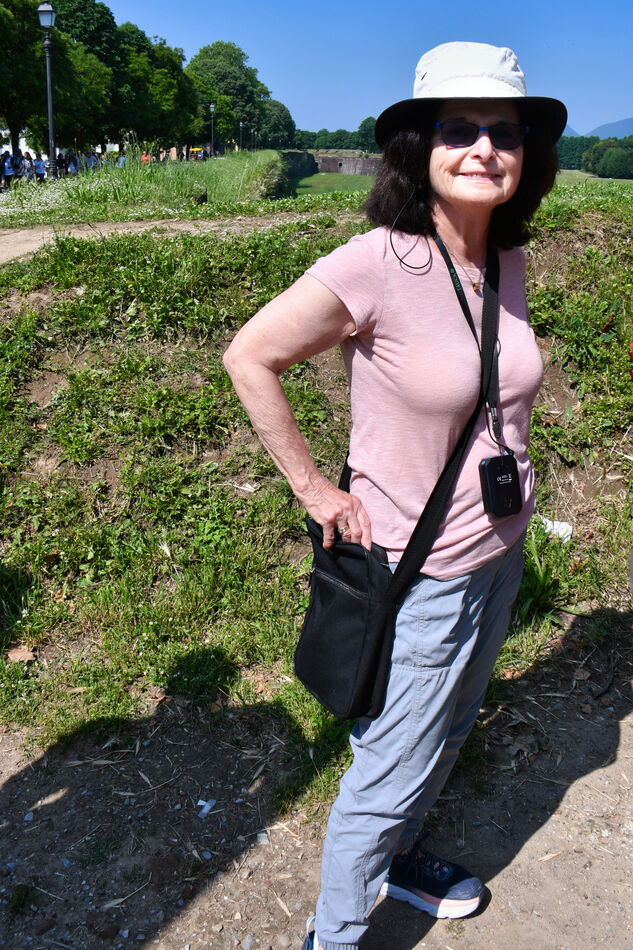
(Download)

(Download)
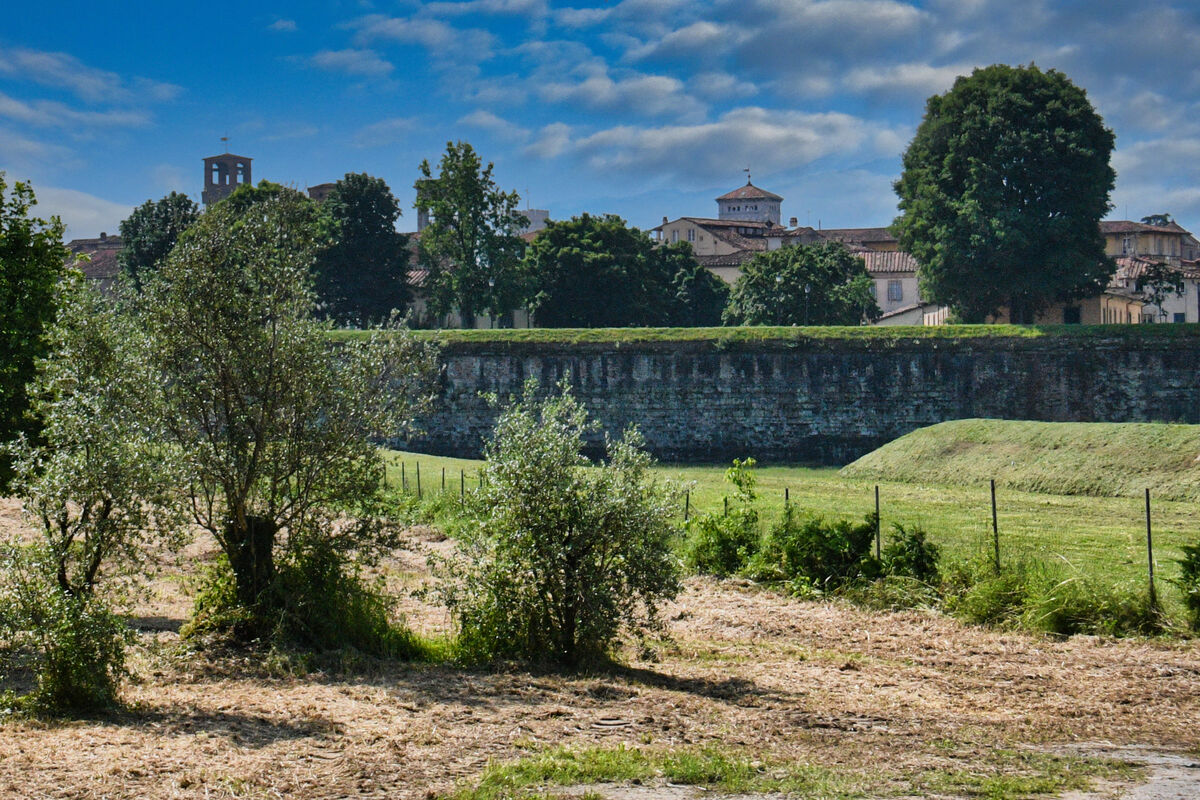
(Download)
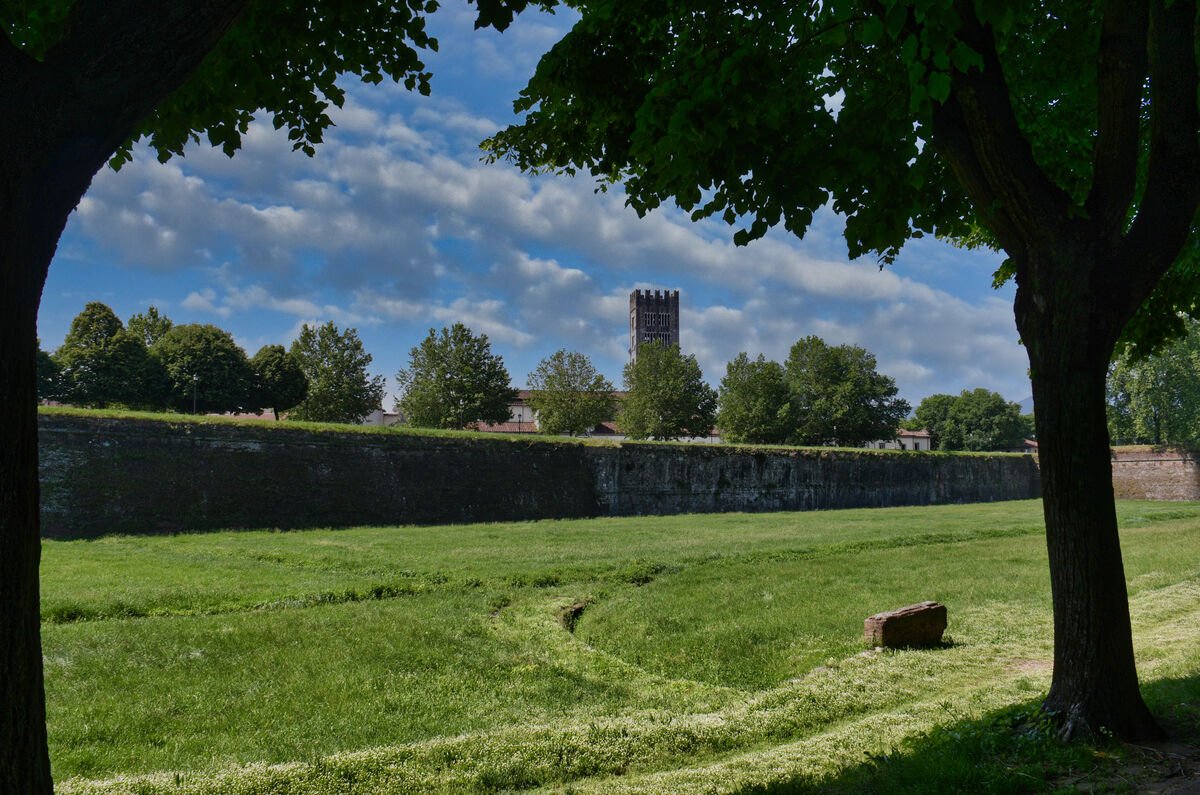
(Download)
The Porta Di Santa Maria. It was established between 1549 and 1592 and is part of the Renaissance city walls. It was designed by the architect Ginese Bresciani and built by Michelangelo Gabrielli .
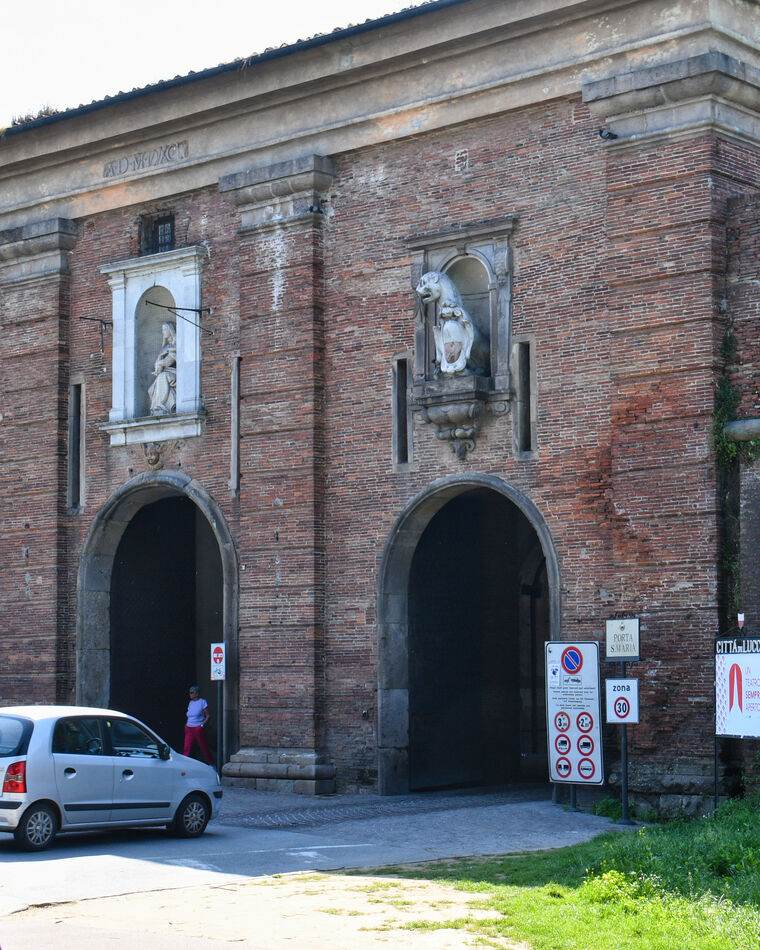
(Download)

(Download)
She was not begging, just resting.
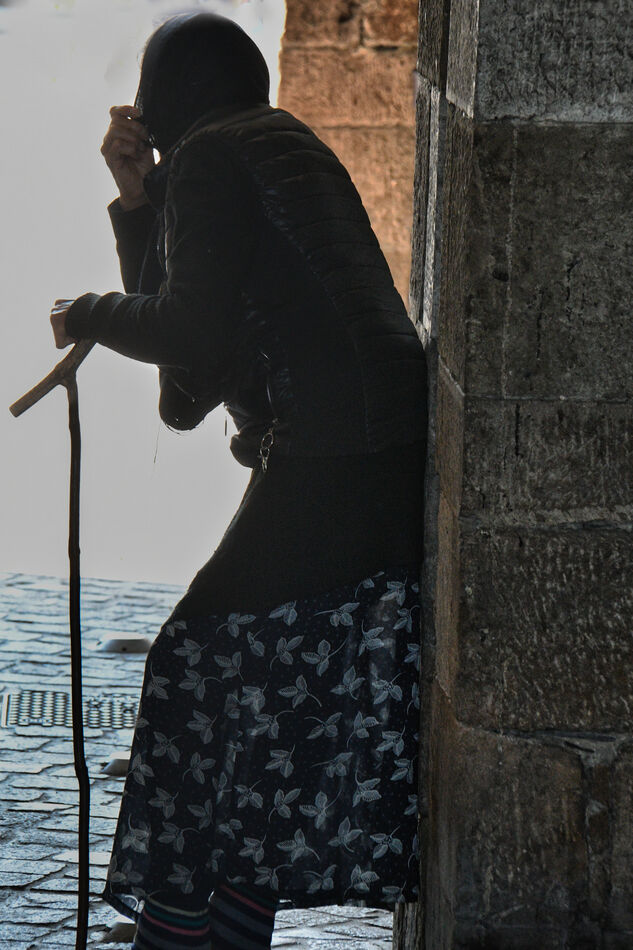
(Download)
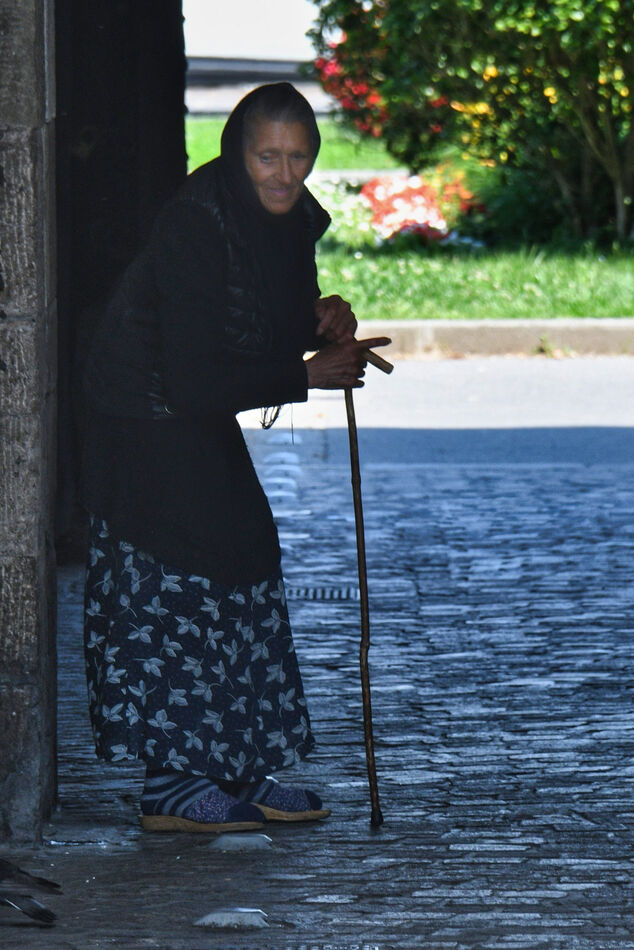
(Download)
One of the ramps up to the wall promenade
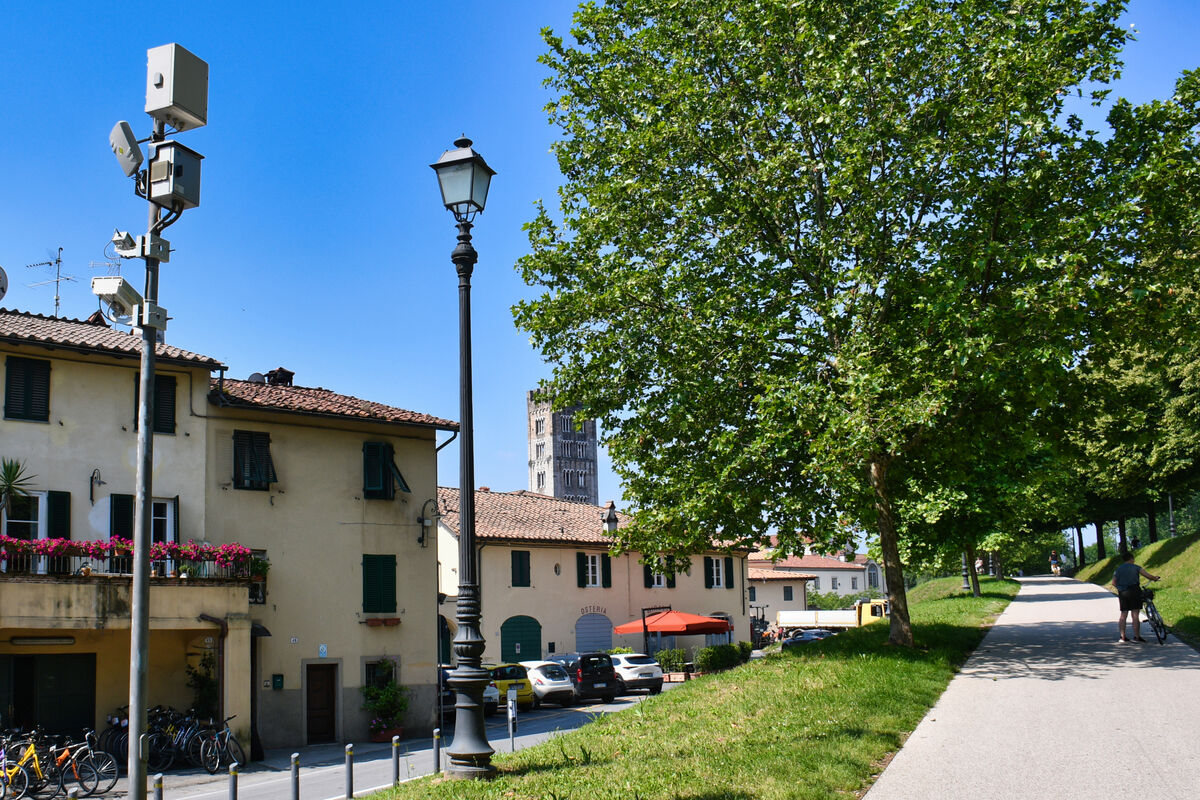
(Download)

(Download)
Dec 27, 2023 14:10:32 #
Dec 27, 2023 14:14:41 #
Dec 27, 2023 14:17:13 #
Dec 27, 2023 15:19:21 #
Dec 27, 2023 16:09:11 #
srfmhg wrote:
We arrived in Lucca in late morning and were given... (show quote)
Great set!!! Mark, Gail is looking quite lovely
Dec 27, 2023 17:18:00 #
Dec 27, 2023 18:05:38 #
NMGal wrote:
A lot of history there. Great photos.
Thanks very much Barbara.
Dec 27, 2023 18:06:55 #
Manglesphoto wrote:
Great set!!! Mark, Gail is looking quite lovely
Thanks so much Frank. I do love that picture of her. I always tell her that she's 77 going on 40!
Dec 27, 2023 18:08:24 #
UTMike wrote:
Excellent tour of a beautiful place with a smashing start, Mark!
Thanks very much Mike. I knew she'd make a hit after her absence in the bus ride sets.
Dec 27, 2023 18:26:07 #
Dec 27, 2023 18:27:49 #
Dec 27, 2023 19:58:35 #
srfmhg wrote:
We arrived in Lucca in late morning and were given... (show quote)
Enjoyed the beautiful tour, mark!
Dec 27, 2023 20:26:03 #
Dec 27, 2023 20:41:26 #
merrytexan wrote:
Enjoyed the beautiful tour, mark!
Thanks so much Merry. Good to hear from you and glad you're enjiying it!
If you want to reply, then register here. Registration is free and your account is created instantly, so you can post right away.










